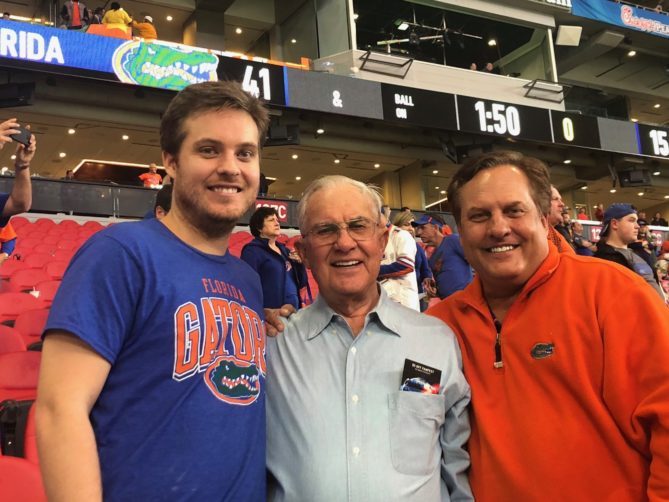
My son, Chase, father, Bill, and I went to the Peach Bowl in Atlanta this past weekend to cheer on the mighty Florida Gators as they defeated the Michigan Wolverines. Afterwards, I was curious how alligators would fare in litigated property insurance cases and the results of my legal research were not so good for policyholders.
“Alligator cracking” is not something policyholders want to see in expert reports. In numerous cases, insurance company expert reports usually associated “alligator cracking” with some form of long term deterioration or wear and tear which is often excluded.
For example, in Nesavich v. Auto-Owners Insurance Company,1 Rimkus Engineering expert Steve Boyd found that certain types of damage were not indicative of hail damage on a particular day. Rimkus engineers often find reasons for their insurance company clients not to pay a claim, but in this case, the dreaded “alligator crack” helped finish off the policyholder’s case:
Boyd observed spatter marks during his inspection, but he concluded that ‘these spatter marks would not be an indicator of the size or direction of the hailstones that fell during the [May 21, 2014 hailstorm] due to the time’ that had passed before his inspection….Boyd also noted various instances of indentations, granular loss, and ‘alligator’ cracking on portions of the buildings…
The Colorado judge ruled in the insurance company’s favor. The lesson from that case is that the policyholder needed to hire his own expert to explain that hail damage occurred on a certain date and to exclude alternative theories of causation. I suppose hiring an engineer from Louisiana or Florida with better familiarity to alligators would help as well.
Another example of “alligator cracking” leading to a finding of no coverage occurred In Schweitzer v. American Family Mutual Insurance Company,2 where the policyholders claimed the weight of a fire truck damaged their driveway during the firefighting efforts. The court noted the following as reasons for denying coverage:
[T]he designated evidence shows that American Family informed the Schweitzers that it had hired an engineer to inspect the driveway to determine if the damages were related to the equipment used to extinguish the fire, that the opinion of the engineer stated in part that the fire truck did not damage the driveway and the driveway was in poor condition with evidence of past repairs in the rutted areas, and that, based upon the finding of the engineer and the policy exclusions, American Family would not be affording coverage for any damage to the driveway. American Family referenced the policy’s language stating that the policy did not cover loss resulting from, among certain other causes, wear and tear or deterioration. American Family also noted the policy’s language providing in part that the policy did not cover loss resulting from faulty, inadequate, or defective construction, repair, or materials used in construction, design, workmanship or specifications, grading or compaction, or maintenance. The engineer’s report, in the analysis and conclusions section, provided in part that ‘[i]t was reported that the fire truck parked in the driveway northeast of the house; therefore none of the damages from that point south to the detached garage were caused by the fire truck.’…The report further provided that the driveway ‘is generally in poor condition with alligator cracking and breakup of the asphalt surface,’ that ‘[t]he condition is caused by insufficient base material and/or wet poorly drained material,’ that ‘[t]he cracking itself is caused by freeze-thaw cycles,’ and that ‘[t]raffic will then knock the material loose and if the base is soft, rutting occurs or if the ground is frozen and surface water is present, potholes form.’
As a final example, in Steven J. Inc, v. Landmark American Insurance Company,3 the court found no coverage and noted:
Landmark contends that several exclusions bar coverage for Steven J.’s claim. Among other exclusions, Landmark cites a provision for ‘[w]ear and tear.’…The court finds support for Landmark’s position in the Halliwell report. In preparing the report, Zajac reviewed aerial photographs of the property from May 2012, evaluated weather data from a nearby site, and inspected the damage to the main building…..With respect to the exterior of the main building, Zajac observed, inter alia, ‘[v]arious ages’ of sealant repairs to the asphaltic roof, alligator cracks in the sealant, buckling and cracked shingles, vegetative growth and organic debris at multiple locations on the roof, blistering and seam separation of roofing materials on the southeast section of the roof, and damage to portions of two gutters and a soffit… In the interior of the building, Zajac found evidence of water intrusion damage, water stains, apparent microbial growth, and rust corrosion at multiple locations… Drawing on meteorological data from an official weather station twelve miles south of the property, Zajac estimated that the maximum sustained wind speeds at the property….were 53 miles per hour, with maximum 5–second wind gusts of 70 miles per hour….These speeds, Zajac noted, are lower than those found in a Category 1 hurricane, which is characterized by sustained winds of 74 to 95 miles per hour.
The Florida Gators are a wonderful team to root for—they always have a wide smile. But, just like the Michigan Wolverines found out on Saturday, gators can take a bite out of your insurance claim if there is any reference by the insurance company to cracking that resembles their skin.
Thought For The Day
“Don’t taunt the alligator until after you’ve crossed the creek.”
—Dan Rather
_________________________________
1 Nesavich v. Auto-Owners Ins. Co., No. 16-cv-01493, 2018 WL 3729513 (D. Colo. Aug. 6, 2018).
2 Schweitzer v. American Family Mut. Ins. Co., 16 N.E. 3d 982 (Ind. App. 2014).
3 Steven J. Inc. v. Landmark American Ins. Co., 2015 WL 3849166, *8 (M.D. Pa. June 22, 2015).



